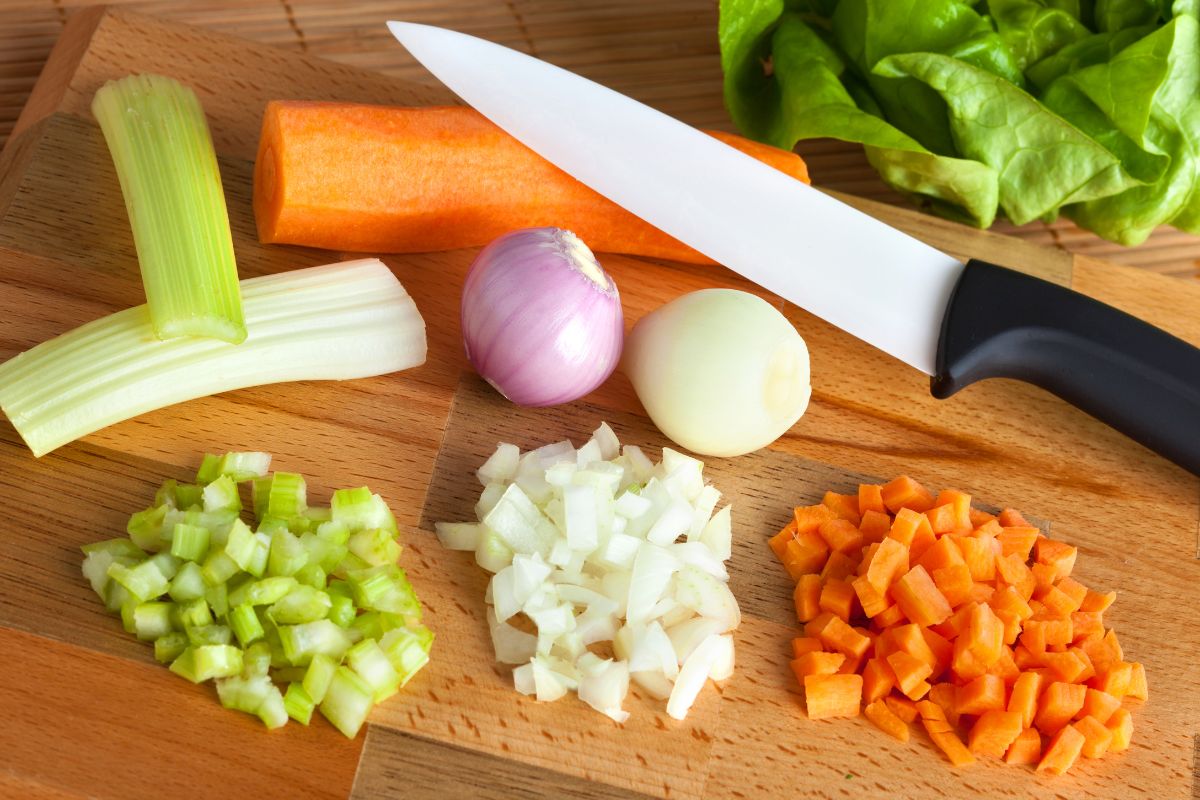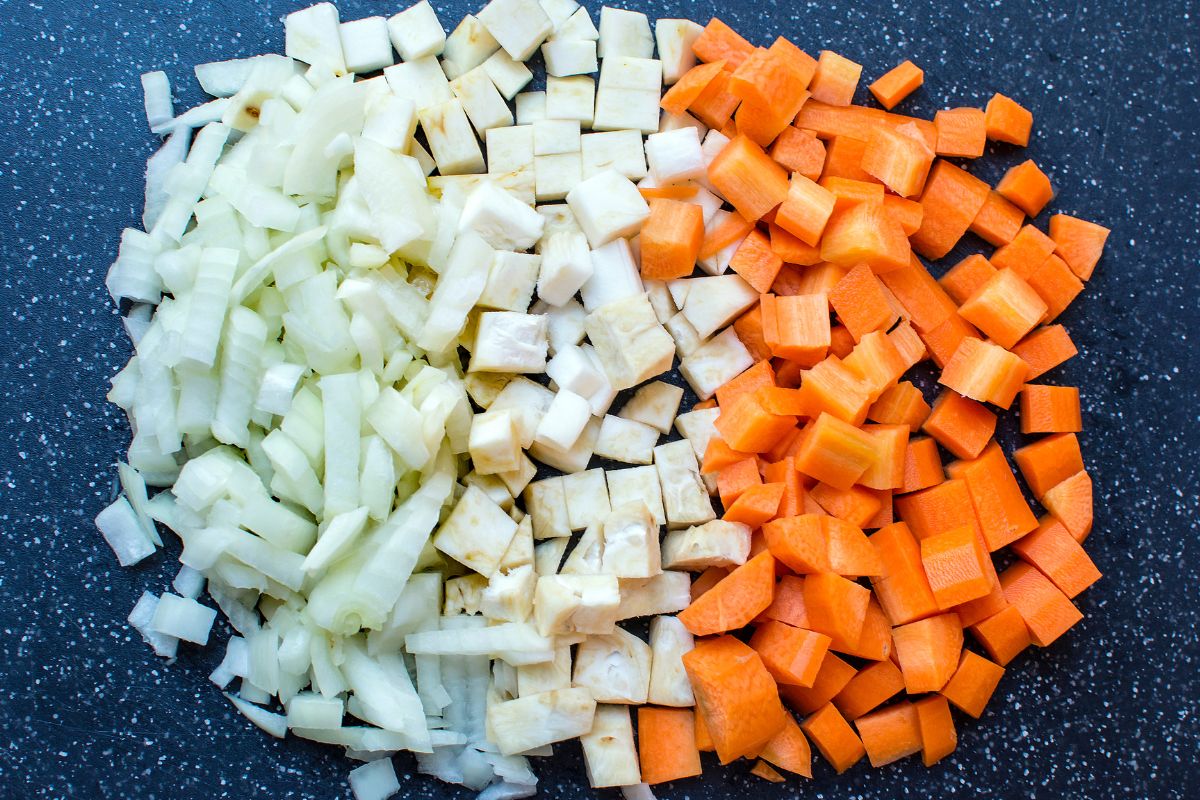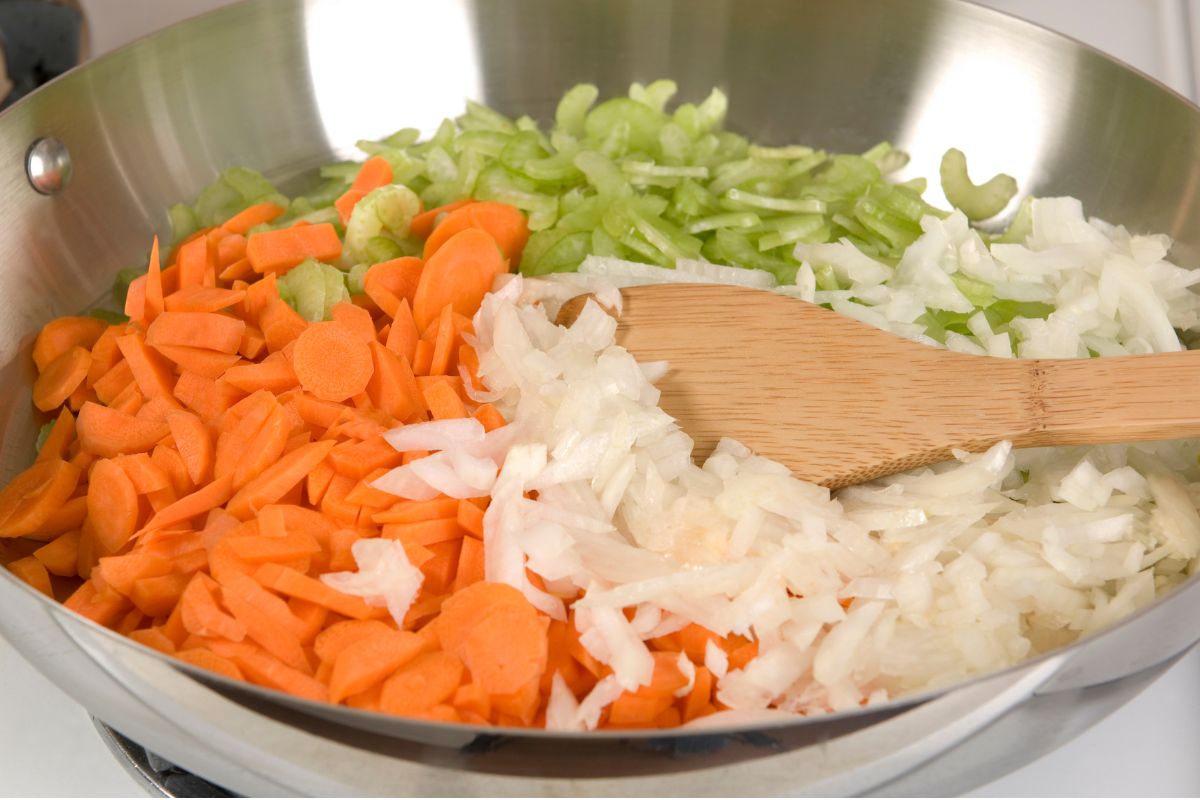What is Soffritto?
It is amazing to learn an Italian soffritto recipe. The base for most sauces, soups, stews and braises in Italian cuisine is soffritto, an aromatic mixture of onion, carrot, and celery.
Although a 2:1:1 ratio of onion, carrot, and celery is widely accepted, some Italian regions prefer to add extra aromatics such as garlic, parsley, rosemary, and bay. You may sometimes add bacon or pancetta for an even richer flavor base.

Mirepoix vs. Soffritto
Although they both call for the same essential components and appear comparable at first glance, there are several important variations between them.
Mirepoix (France)
Soffritto is the French equivalent of mirepoix, essentially diced vegetables sautéed in butter over low heat for an extended period. Many consider mirepoix to be the French equivalent of soffritto.
Instead of sautéing the soffritto vegetables, the goal is to bring out their natural sweetness by using this method.
To put it another way, it is quite similar to soffritto, with the primary difference being that the objective is not to brown or caramelize the veggies. Depending on the recipe for their use, you can mince or cut them into cubes. In most cases, it also contains tomato paste, which is responsible for giving the finished product its dark brown color.
The Soffritto Dish (Spain)
The Spanish word means “to lightly fry something,” and it is the cousin of the Italian word soffritto. This is obvious due to the slight differences in spelling between the two words. soffritto is a cooking method that originates from Catalonia, Spain.
Still, it has since made its way throughout the rest of the country and even to Spain’s former colonies in the Caribbean and Latin America. soffritto is a regional specialty in Catalonia. It is especially popular in the Dominican Republic and Puerto Rico, known locally as sazon and recaito.
According to historians, the traditional recipe for soffritto called for bacon or any other type of salted pork that they saute with onions or leeks, or both. The recipe has been changing over the years to include various herbs, spices, and vegetables. In modern times, garlic, onions, paprika, peppers, tomatoes, and soffritto are the standard ingredients for a basic soffritto.
How to Saute Celery and Onions
If you prefer tender celery, you should boil it. Still, if you want to retain more vegetable nutrients, you should steam it rapidly. The stir-frying or sautéing methods are other excellent choices, particularly if you prefer your celery to have a slight crunch rather than be completely tender.
It should take about five minutes for the celery to become soft but not mushy. In a skillet, combine the butter and the vegetables, and cook over medium heat until the three kinds of vegetables have become translucent (about five minutes).
Available Soffritto Recipe Variations
Regional and personal modifications can include these extra ingredients that you can add to the traditional recipe for soffritto. The traditional recipe for soffritto is likely varied in different parts of Italy.
Fish, vegetables, and legumes are some of the meals that benefit from the excellent flavor that brings garlic to the table. Garlic is exceedingly delicate. It has a high risk of igniting, particularly when you slice or mince it into smaller pieces. When the soffritto is almost cooking, add it to the components already in the pan with the rest of the ingredients.
In preparing legumes or meat such as pork, beef, or chicken, it is common practice to use aromatic herbs like rosemary (fresh or dried), bay leaves, sage, or thyme in soffritto. One more well-liked option is to use thyme. A soffritto will never have any basil or mint, although it may contain fresh parsley.
An extra savory modification that is particularly common in some areas includes chopped pieces of meat such as pancetta, guanciale, or bacon. This adds an interesting texture to the dish as well. You need to add them to the saucepan without delay, and at the same time, you should reduce the amount of oil or butter used in the dish as a whole.
You can make your soffritto more delicious by adding the following to it:
- Wine: Including even a small amount of either white or red wine in your dish imparts an astounding amount of flavor and is an excellent complement to meat and beans.
- Spices: Fresh red chile or chili flakes are quite common, and you may add them to soffritto when you first cook it. The majority of the time, recipes do not call for the use of other spices like paprika, cumin, or turmeric.

An Italian Soffritto Recipe to Try
In any Italian kitchen, this straightforward recipe for soffritto is necessary for making the vast majority of sauces, soups, and stews. It is not a dish in and of itself; it is an essential flavor base that you can prepare quickly and easily!
Prep time: 5 mins
Cook time: 10 mins
Total time: 15 mins
Serving size: 2 servings
Nutritional Facts
- Calories: 323kcal
- Carbohydrates: 0.6 ounces (17 grams)
- Protein: 0.07 ounces (2 grams)
- Fat: 0.99 ounces (28 grams)
- Saturated fat: 0.14 ounces (4 grams)
- Fiber: 0.14 ounces (4 grams)
- Sugar: 0.28 ounces (8 grams)
Equipment Needed
- A sharp knife
- A large saucepan
Ingredients
- 1 medium-size onion, peeled and diced
- 1 medium-size carrot, peeled and diced
- 1 Celery rib, diced
- 1-2 tbsps olive oil, extra virgin olive oil, or butter
Instructions
- Clean the soffritto vegetables by rinsing them, peeling the onion, carrot, and celery, trimming the ribs, and removing the leaves.
- Cut the onion, carrots, and celery using a sharp knife into very small pieces. Make an effort to maintain the same size. Use a cutting board and carefully handle your knife at all times.
- Heat the olive oil in a saucepan or a skillet at a heat setting between low and medium. Using 1 to 2 tablespoons of olive oil or an equivalent amount of butter is sufficient. When the oil begins to shimmer, add the diced vegetables and continue cooking while stirring frequently.
- If necessary, reduce the heat to low and continue to sauté the meat until it is golden brown; this should take anywhere from five to 20 minutes, depending on how patient you are.
- When the soffritto is almost cooking, you can add minced garlic, aromatic herbs, spices, wine, or all of these. After giving everything a good stir and continuing to cook it for another minute or two, you can add the remaining ingredients following the recipe you want to make.
Notes
- Do not brown the vegetables; cook the soffritto slowly until soft, releasing all the flavors without browning, caramelizing, or scorching them. Scorching them may completely change or add undesired flavor to the vegetables.
- If you increase the heat to sauté the vegetables faster, they will not release the same flavor and will be more prone to burning.
- What knife to use – To cut the veggies as finely as possible, you’ll need a sharp knife, such as a chef’s knife or a mezzaluna, which is a curved, double-handled Italian knife. You can easily cut veggies and herbs with this tool if you use a rocking motion.
- Use the same amount of each ingredient – there is no rule about how much or how little you should use; it all depends on what you’re preparing. However, it’s crucial to have nearly equal amounts of each veggie once chopped. You don’t want one veggie to dominate the rest of the dish.
- To be more adventurous with your cooking, add fresh herbs, garlic, pancetta, or fat to enhance the flavor. Italian cuisine is particularly regional, and you can add new flavors to the basis. Pick your favorites and get to work!
- You can store uncooked soffritto in the refrigerator for three to four days or frozen for up to three months. You can use it straight from the freezer.
Can You Freeze Pre–Made Soffritto Mix?
The best soffritto mix is always fresh, and it is so simple to prepare. On the other hand, you can certainly prepare a large quantity of battuto, which is raw vegetables that you mince and use for soffritto, and then freeze the remaining battuto in a freezer bag; this is ideal for busy cooks.
You can follow the same process when making your parsley pesto, another flavorful kitchen staple that can be useful.
Soffritto Serving Suggestions
A magical combination of vegetables forms the foundation of many different cuisines. It is the source of many intricate and nuanced flavors. In French cuisine, these three vegetables are mirepoix: onions, carrots, and celery. Bell peppers, onions, and celery are the holy trinity of ingredients in Cajun cooking.
Onions, ginger, and garlic are common ingredients at the beginning of many Indian dishes. soffritto is the foundation of a good dish in many different types of cooking, including Spanish, Latin American, and Portuguese, amongst other cuisines.
Onions, bell peppers, tomatoes, and garlic are the standard ingredients for a soffritto. You cook these ingredients over low heat in oil. The components call for a subtle adjustment when you change the dish. Olive oil is an essential component in Catalan meals.
In contrast, cilantro is frequently an ingredient in Puerto Rican soffritto. On the other hand, if you’re going to be cooking a lot of Cuban dishes, for example, you’re going to find that you go through a lot of soffritto. Because it is a fundamental component of a wide variety of cuisines, many manufacturers, such as Goya, sell it already prepared in a jar in several different flavors.
In a time crunch, soffritto that comes in a jar or frozen is a good option; however, making your soffritto from scratch allows you to season the base according to your preferences. In addition, once you have prepared a large quantity of soffritto, you may freeze the amount you are not using in a quart container or a bag with a zip-top.
This provides the same ease as purchasing the foundation already prepared but at a lower cost.
How can other dishes make use of soffritto once you prepare it? There are so many delicious meals you can serve with soffritto.
Served with Rice and Chicken
This recipe for Chicken soffritto, which takes its inspiration from Spanish cuisine, calls for you to add the soffritto to the pan along with rice, herbs, spices, jalapenos, and chicken stock to impart flavor and heat to the rice. If you don’t like things too spicy, feel free to leave off the chili powder coating applied to the chicken legs; this step is optional.
Huevos Rancheros
Following the instructions in this recipe for Huevos Rancheros, you can substitute soffritto for the fresh salsa in the dish. In this recipe, the soffritto receives an extra kick of smokiness and flavor thanks to the addition of smoked ham and Scotch Bonnet chilies.
Soup Made with Black Beans
These onions, peppers, and garlic provide the base for a quick and delectable vegetarian black bean soup. Adding a homemade habanero crema takes the soup to a new level of deliciousness.
Brown Rice and Beans
Starting with a soffritto is the first step in making many Cuban black beans. Still, you can also modify it to use in various other bean meals if you want to get creative. The method remains the same: add the beans and the liquid you will be cooking into the soffritto and other appropriate herbs and spices.

Your Soffritto, Your Way!
It is a well-known fact that there has recently been a rise in the prevalence of cooking methods that consider one’s health. It should be no surprise that an increasing number of people are exercising caution concerning the foods they consume, given the proliferation of several dangerous medical disorders.
Do you know that in traditional Italian cooking, the use of healthful ingredients, particularly fresh vegetables, and herbs, has more or less been a staple for many dishes? But did you know that? soffritto, the flavorful Italian base used in a wide variety of classic dishes, is a good example.
The first thing you should know is that you must cook Italian soffritto simultaneously as the dish that asks for it.
Many soffritto recipes Italian recommend cooking the vegetables first and then storing them for later use, but this is not how the Italians do it (at least not the 99 percent of them). The methods differ; sometimes, you cook the soffritto first, while other times, you cook it second.
Of course, you may create a huge batch of soffritto, cook it, and freeze it, but we wouldn’t recommend it for classic meals like bolognese sauce or Minestrone. Rather, use it as a flavor enhancer by adding a teaspoon to pasta recipes, salads, and other dishes. Consider sauces like pesto, sometimes used as a garnish rather than the main element.

Community of passionate writers and content creators who share a love for Italian heritage, culture, travel, food, and the Italian-American community. Our mission is to celebrate Italy’s rich history and traditions and connect with others who share the same passion.

